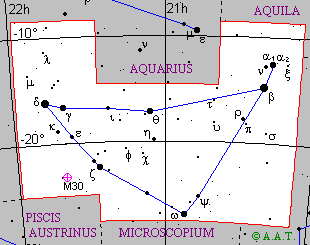 |
 |
| English name | Capricorn | ||||
|---|---|---|---|---|---|
| Major stars | beta Capricorni | Dabih | magn. 3,3 | RA: 20h 21m 00.67s | Dec: -14° 46' 52.9" |
| delta Capricorni | Deneb Algedi | magn. 3,0 | RA: 21h 47m 02.42s | Dec: -16° 07' 37.5" | |
| Description | Constellation of the zodiac, through which the Sun transits from the end of January to the middle of February. In past times the Sun was in Capricornus at the winter solstice (December 21), at the point of maximum south distance from equator. Today, because of the precession of the equinoxes, the winter solstice is in Sagittarius, but the latitude at which the Sun appears to zenith in that day is still called Tropic of Capricorn. Among the interesting stars of the constellation there is alpha Capricorni (Algedi, that is "wild goat", in Arab), constituted by two couples of independent stars: alpha1 Capricorni, composed by two stars of magnitude 4 and 9, and alpha2 Capricorni, formed by two stars of magnitude 4 and 11.
|
||||
| Mythology and history | Capricornus is a fantastic animal with the head and the anterior legs of a goat and the tail of a fish. The Greeks identified him with Pan, the god of pastures and wild nature. Despite his messy and lustful character, Pan helped the gods on two occasions: during the battle against the Titans he threw into disorder the enemies lines by blowing in a shell; then, he warned Zeus that the monster Tepheus was approaching. To thank him for his services, Zeus put Pan's image in the sky. |
||||
 Back to constellations page.
Back to constellations page.